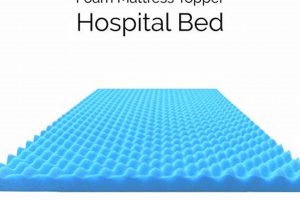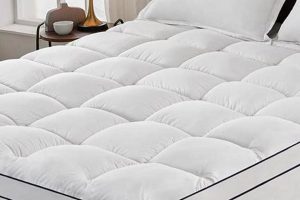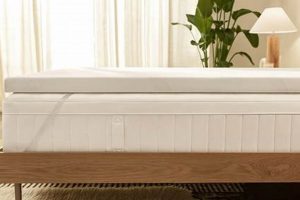This bedding accessory, crafted from natural fibers, serves as a protective and comfort-enhancing layer placed atop a mattress. It aims to augment the sleeping experience through added cushioning and temperature regulation. Sourced from sheep raised according to specific agricultural standards, the material used avoids synthetic chemicals during its production and processing.
The significance of incorporating this element into sleep systems stems from its potential to improve sleep quality and promote a healthier sleep environment. Its inherent breathability helps regulate body temperature, preventing overheating during warmer months and providing insulation in cooler conditions. Historically, natural fibers like this have been valued for their durability, comfort, and sustainable properties.
The following sections will delve into the sourcing and processing of these materials, explore their benefits in greater detail, and provide guidance on selecting and caring for such a bedding product to maximize its lifespan and effectiveness.
Selection and Maintenance Guidance
This section offers guidance on choosing and caring for a bedding enhancement crafted from natural fleece, ensuring optimal performance and longevity.
Tip 1: Verify Certification: Prioritize products bearing certifications such as GOTS (Global Organic Textile Standard). These certifications ensure the material meets stringent criteria regarding the origin and processing of the wool, limiting exposure to harmful chemicals and ensuring ethical farming practices.
Tip 2: Assess Density and Thickness: Consider the desired level of cushioning and support. A denser and thicker product will generally provide greater support and pressure relief, while a thinner one may be more suitable for those seeking minimal alteration to the existing mattress feel.
Tip 3: Evaluate Wool Source: Research the origin of the wool. Merino wool, known for its softness and fine fibers, is often considered a premium option. Understanding the breed of sheep and the farming practices can provide insights into the quality and ethical sourcing of the material.
Tip 4: Consider Mattress Size and Dimensions: Ensure the selected product corresponds accurately to the dimensions of the mattress. An ill-fitting topper can shift and bunch, compromising comfort and potentially damaging the bedding material.
Tip 5: Implement Proper Cleaning Procedures: Adhere to the manufacturer’s cleaning instructions. Typically, spot cleaning with a mild detergent is recommended. Avoid machine washing or drying, as these processes can damage the wool fibers and alter the topper’s structure. Professional cleaning services specializing in natural fibers may be considered for deep cleaning.
Tip 6: Use a Protective Cover: Utilize a mattress protector underneath the topper to guard against spills and stains. This adds a layer of protection to the wool and helps maintain its cleanliness and hygiene over time.
By adhering to these recommendations, consumers can optimize the benefits derived from a bedding accessory made from natural fleece, promoting a healthier and more restful sleep environment.
The subsequent segments will summarize the core advantages and present a conclusion encapsulating the overall significance of opting for natural bedding materials.
1. Material Certification
Material certification serves as a verification system, ensuring that a bedding accessory, specifically an organic wool mattress topper, adheres to predetermined standards concerning the origin, processing, and composition of its constituent materials. This process is crucial for verifying claims of “organic” status and guaranteeing a product’s safety and environmental integrity.
- Verification of Organic Origin
Certifications like GOTS (Global Organic Textile Standard) confirm that the wool used originates from sheep raised according to organic agricultural practices. This includes prohibiting the use of synthetic pesticides, herbicides, and genetically modified organisms (GMOs) in animal feed and pasture management. This aspect is crucial for consumers seeking assurance that the wool production minimizes environmental impact and adheres to animal welfare standards.
- Restriction of Harmful Substances
Certified products undergo testing to ensure they are free from harmful chemicals, such as formaldehyde, heavy metals, and persistent organic pollutants (POPs). These substances can pose health risks if present in bedding materials. Certification provides a guarantee that the manufacturing process avoids the use of such chemicals, creating a safer sleep environment.
- Ethical and Social Responsibility
Beyond environmental considerations, some certifications also encompass ethical and social responsibility criteria. This includes ensuring fair labor practices throughout the supply chain, protecting worker rights, and promoting sustainable economic development in wool-producing regions. Consumers may find value in supporting brands that prioritize these aspects of sustainability.
- Traceability and Transparency
Certification systems often require traceability measures, allowing the origin of the wool to be tracked from the farm to the finished product. This transparency provides consumers with greater confidence in the accuracy of product claims and facilitates accountability within the supply chain. It reinforces the integrity of the organic label and helps prevent fraudulent claims.
These facets collectively demonstrate the vital role of material certification in ensuring the integrity of an organic wool mattress topper. By verifying the origin, composition, and ethical production of the wool, certification empowers consumers to make informed purchasing decisions and supports environmentally and socially responsible manufacturing practices within the bedding industry.
2. Temperature Regulation
Temperature regulation, concerning bedding materials, refers to the capacity to mitigate temperature fluctuations, creating a stable thermal environment for the sleeper. Within an organic wool mattress topper, this characteristic significantly impacts sleep quality and comfort, minimizing disruptions caused by overheating or excessive cooling.
- Wicking Ability and Moisture Management
Wool fibers possess inherent wicking capabilities, efficiently drawing moisture away from the body. This moisture is then released into the air through evaporation. By reducing humidity in the immediate sleeping environment, wool minimizes the likelihood of discomfort associated with perspiration and prevents the feeling of being damp or chilled. Individuals experiencing night sweats or residing in humid climates may particula
rly benefit from this attribute. - Insulative Properties and Thermal Buffer
The crimped structure of wool fibers creates air pockets, acting as a natural insulator. These air pockets trap body heat during cooler periods, providing warmth and preventing heat loss. Conversely, during warmer periods, the same air pockets allow for air circulation, dissipating excess heat and preventing overheating. This creates a thermal buffer, stabilizing temperature within a comfortable range regardless of external conditions.
- Fiber Structure and Breathability
Unlike synthetic fibers that can restrict airflow, wool’s porous structure permits air circulation through the mattress topper. This breathability facilitates the continuous exchange of air, reducing the accumulation of heat and moisture. Individuals tend to experience a more consistent and comfortable sleeping temperature because of the inherent air circulation.
- Natural Climate Control
The combination of wicking ability, insulation, and breathability contributes to the overall climate control function of an organic wool mattress topper. This system dynamically adjusts to the sleeper’s body temperature, reacting to changes in environmental conditions, and mitigating external thermal fluctuations. This provides a balanced and consistent sleep microclimate that remains unaffected by external temperature changes.
These interlinked properties of moisture management, insulation, fiber structure, and climate regulation work synergistically to enhance sleep comfort and quality. The integration of natural fibers allows for consistent thermal regulation that distinguishes organic wool bedding accessories, providing increased comfort to consumers by ensuring a steady sleep climate.
3. Comfort and Support
The integration of comfort and support into an organic wool mattress topper directly impacts the sleep experience. The comfort aspect addresses the tactile sensation and subjective feeling of ease experienced by the user, while support refers to the topper’s ability to maintain proper spinal alignment and distribute weight evenly. The wool fibers, when properly processed and constructed, create a cushioning layer that conforms to the body’s contours. A tangible outcome of this conformation is reduced pressure on joints and muscles, leading to decreased tossing and turning during sleep. The presence of both attributes distinguishes effective sleep surfaces, as either excessive comfort without adequate support or vice-versa can compromise rest quality.
The density and construction of the wool batting are crucial factors influencing the level of support provided. A denser topper will generally offer firmer support, suitable for individuals requiring additional spinal stabilization. Conversely, a lighter, less dense topper will provide a softer, more conforming feel. For instance, an individual with chronic back pain might benefit from a denser topper that prevents spinal compression, while a lighter topper could provide adequate comfort for someone without specific orthopedic concerns. Therefore, the selection process necessitates a careful evaluation of individual needs and preferences in relation to the topper’s structural characteristics.
The symbiotic relationship between comfort and support within an organic wool mattress topper results in a holistic improvement to sleep. By providing a conforming and pressure-relieving surface, while simultaneously maintaining proper spinal alignment, these toppers contribute to a more restful and restorative sleep cycle. The correct balance promotes reduced muscle tension, improved circulation, and minimized sleep disturbances. While challenges exist in precisely quantifying subjective comfort levels, the demonstrable impact of appropriate support on orthopedic health and sleep quality underscores the practical significance of prioritizing both comfort and support in the selection of organic bedding materials.
4. Hypoallergenic Properties
The association between hypoallergenic properties and an organic wool mattress topper arises from the inherent characteristics of wool and the production methods employed in creating an “organic” product. One primary factor contributing to reduced allergenicity is the natural resistance of wool fibers to dust mites. Dust mites, common triggers for allergies and asthma, thrive in warm, humid environments and find suitable habitats in conventional bedding. Wool fibers, however, possess a scaly outer layer (epidermis) that makes it difficult for dust mites to colonize. Furthermore, the breathability of wool fibers prevents the buildup of moisture, creating an inhospitable environment for these allergens. For instance, individuals with respiratory sensitivities often find relief when switching from synthetic bedding to wool products due to the diminished presence of dust mite allergens.
Another crucial aspect is the avoidance of harsh chemicals in the processing of organic wool. Conventional wool production often involves the use of chemical scouring agents, dyes, and flame retardants, which can trigger allergic reactions in susceptible individuals. In contrast, organic wool production adheres to stringent guidelines that prohibit the use of such substances. This reduces the potential for chemical sensitivities and enhances the hypoallergenic nature of the mattress topper. For example, a study published in the Journal of Allergy and Clinical Immunology indicated that exposure to certain flame retardants commonly used in bedding materials correlated with increased incidence of allergic dermatitis.
In summary, the hypoallergenic properties of an organic wool mattress topper are a direct result of both the natural attributes of wool fibers and the absence of irritating chemicals in its production. This combination minimizes the presence of common allergens, creating a healthier sleep environment for individuals with sensitivities or allergies. Although wool allergies are possible, they are relatively rare compared to dust mite or chemical sensitivities. The overall benefits highlight the practical significance of understanding these properties in relation to improved sleep quality and reduced allergic reactions.
5. Durability and Longevity
The inherent qualities of the raw material and the manufacturing processes employed directly influence the lifespan of a bedding accessory. For an organic wool mattress topper, durability and longevity are critical factors affecting its long-term value and sustainability.
- Fiber Strength and Resilience
Wool fibers, particularly those from specific breeds of sheep known for their fleece quality, possess considerable tensile strength and resilience. This inherent robustness allows the topper to withstand repeated compression and release cycles encountered during sleep. The fiber’s ability to recover its original shape after deformation contributes to the topper’s long-term structural integrity, resisting premature flattening or sagging. For example, a topper constructed from long-staple Merino wool is likely to maintain its loft and supportive qualities for a lo
nger period compared to one made from shorter, less resilient fibers. - Natural Resistance to Degradation
Wool contains lanolin, a natural wax that provides resistance to moisture, dirt, and microbial growth. This protective barrier helps prevent the breakdown of the fibers caused by environmental factors. Furthermore, wool’s inherent fire-resistant properties, stemming from its high nitrogen and water content, reduce the need for chemical flame retardants, which can accelerate fiber degradation over time. This resistance to degradation contributes directly to the product’s longevity and sustained performance.
- Manufacturing Techniques and Construction
The methods used to process and assemble the wool batting into a mattress topper significantly impact its overall durability. Techniques such as needle-punching or layering and quilting create a cohesive structure that prevents clumping and shifting of the wool fibers. High-quality stitching and reinforced edges further enhance the topper’s ability to withstand wear and tear. For instance, a topper with evenly distributed wool batting and securely stitched seams is less likely to develop thin spots or unravel over time, ensuring a consistent level of support and comfort throughout its lifespan.
- Proper Care and Maintenance
The lifespan of an organic wool mattress topper is also dependent on the care it receives. Regular airing and spot cleaning can help maintain its cleanliness and prevent the buildup of odors and allergens. Avoiding harsh detergents or excessive moisture exposure is crucial to preserving the integrity of the wool fibers. Storing the topper properly when not in use, such as in a breathable cotton bag, can further extend its lifespan. Adhering to the manufacturer’s care instructions is essential for maximizing the durability and longevity of the bedding accessory.
The multifaceted interplay between fiber characteristics, natural resistance to degradation, manufacturing techniques, and diligent care ensures that an organic wool mattress topper can provide years of comfortable and supportive sleep. While the initial investment may be higher compared to synthetic alternatives, the extended lifespan and sustained performance of a well-constructed and properly maintained topper offer long-term value and align with principles of sustainable consumption.
Frequently Asked Questions
This section addresses common inquiries regarding organic wool mattress toppers, providing clarity on their properties, benefits, and maintenance.
Question 1: What distinguishes an organic wool mattress topper from a conventional wool topper?
An organic wool mattress topper utilizes wool sourced from sheep raised according to organic agricultural standards, prohibiting synthetic pesticides, herbicides, and genetically modified feed. Conventional wool toppers may not adhere to these restrictions, potentially exposing consumers to chemical residues.
Question 2: How does an organic wool mattress topper contribute to temperature regulation during sleep?
Wool fibers possess inherent breathability and moisture-wicking properties. These characteristics facilitate air circulation and prevent the buildup of moisture, allowing the topper to maintain a comfortable sleep temperature throughout the night. This reduces instances of overheating or excessive cooling.
Question 3: Is an organic wool mattress topper suitable for individuals with allergies?
Organic wool mattress toppers are generally considered hypoallergenic due to the natural resistance of wool fibers to dust mites and the avoidance of harsh chemicals in processing. However, individuals with known wool allergies should exercise caution. Confirm that no additional substances were added that could cause allergic reaction.
Question 4: What is the recommended method for cleaning an organic wool mattress topper?
Spot cleaning with a mild detergent is generally recommended. Machine washing or drying is typically discouraged, as these processes can damage the wool fibers. Professional cleaning services specializing in natural fibers may be considered for thorough cleaning.
Question 5: How can the lifespan of an organic wool mattress topper be maximized?
Regular airing, spot cleaning, and the use of a mattress protector can help extend the lifespan. Storing the topper in a breathable bag when not in use can also protect it from dust and moisture. Adhering to the manufacturer’s care instructions is crucial.
Question 6: What certifications should one look for when purchasing an organic wool mattress topper?
Certifications such as GOTS (Global Organic Textile Standard) provide assurance that the wool meets stringent criteria regarding its origin, processing, and environmental impact. These certifications ensure that the product adheres to organic standards and minimizes exposure to harmful chemicals.
In summary, organic wool mattress toppers offer a range of benefits related to comfort, temperature regulation, and reduced allergen exposure. Proper care and maintenance are essential for maximizing their lifespan.
The subsequent section will provide a conclusion encapsulating the value proposition of selecting organic bedding solutions.
Conclusion
The preceding sections have presented an exposition of the attributes associated with the bedding accessory, specifically crafted with natural fleece. Discussions have encompassed sourcing, processing, benefits pertaining to sleep quality and temperature modulation, care guidelines, and commonly raised inquiries. Core determinants explored include certification benchmarks, thermal regulation capabilities, comfort dimensions, potential for mitigating allergen exposure, and durability considerations.
The decision to incorporate an organic wool mattress topper should be an informed one, predicated upon a comprehensive evaluation of individual needs and preferences. Its value proposition is embedded in its potential to contribute toward a more sustainable consumption model, and an improved sleep environment. The information presented herein serves as a factual resource to augment the decision-making process of prospective consumers.







